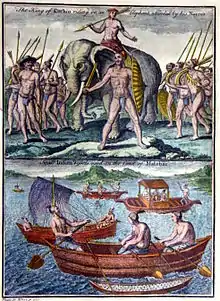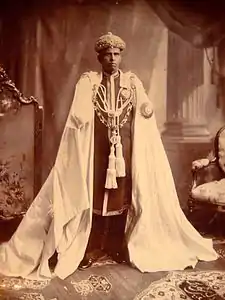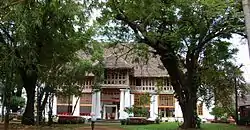History of Kochi
Kochi is a metro city located in the Ernakulam District in the Indian state of Kerala. Kochi, which is the largest city in Kerala is located about 200 km from Trivandrum capital of Kerala.
| Timeline of Kochi | |
 | |
| Year | Event |
| 1102 | The kingdom of Kulasekhara breaks up, and the Cochin State is formed. |
| 1341 | The port at Kodungallur is destroyed in a massive flooding in the Periyar. The prominece of Kochi as a trading post increases. |
| 1440 | Italian traveller Niccolò Da Conti visits Kochi |
| 1500 | Portuguese Admiral Pedro Álvares Cabral, lands at Kochi. |
| 1503 | Kingdom of Kochi is taken over by the Portuguese. |
| 1530 | Saint Francis Xavier arrives and introduces a Christian mission. |
| 1663 | Portuguese rule overthrown by the Dutch. |
| 1664 | Dutch establish municipality of Fort Kochi, the first municipality in Indian subcontinent |
| 1773 | Mysore King, Hyder Ali's conquest descends on Kochi. |
| 1814 | Anglo-Dutch Treaty of 1814 officially passes the city to the United Kingdom |
| 1947 | India gains independence, Kochi joins the Indian Union. |
| 1956 | The State of Kerala is formed. |
| 1967 | Kochi Corporation comes into existence. |
For many centuries up to and during the British Raj, the city of Kochi was the seat of the eponymous princely state. Kochi traces its history back many centuries, when it was the centre of Indian spice trade for hundreds of years, and was known to the Yavanas (Greeks and Romans), Jews, Arabs and Chinese since ancient times.[1] Kochi earned a significant position on the world trading map after the port at Kodungallur (Cranganore) was destroyed by massive flooding of the river Periyar in 1341.[2]
The earliest documented references to Kochi occur in the books written by Chinese voyager Ma Huan, during his visit to Kochi in the 15th century as part of the treasure fleet of Admiral Zheng He.[3] There are also references to Kochi in accounts written by Italian traveller Niccolò Da Conti, who visited Cochin in 1440.[4]
Today, Kochi is the commercial hub of Kerala,[5] and one of the fastest growing second-tier metropolises in India.[6]
Prehistory
Not much is known about the prehistory of Kochi. There has been no clear evidence of Stone Age habitation. Kochi forms the central part of the Megalithic belt of Kerala. The only trace of prehistoric life in the region is the menhir found in Tripunithura.
Princely rule

The early history of Kochi is not well documented. Kochi's prominence as a trading port grew after the collapse of the port at Kodungallur in 1341 AD.
The Cochin State came into existence in 1102 AD after the breaking up of the Kulasekhara empire.[7]
On the Malabar coast during the early 15th century, Calicut and Kochi were in an intense rivalry, so the Ming dynasty of China decided to intervene by granting special status to Kochi and its ruler known as Keyili (可亦里) to the Chinese.[8] Calicut had been the dominant port-city in the region, but Kochi was emerging as its main rival.[8] For the fifth Ming treasure voyage, Admiral Zheng He was instructed to confer a seal upon Keyili of Kochi and enfeoff a mountain in his kingdom as the Zhenguo Zhi Shan (鎮國之山, Mountain Which Protects the Country).[8] Zheng He delivered a stone tablet, inscribed with a proclamation composed by the Yongle Emperor himself, to Kochi.[8] As long as Kochi remained under the protection of Ming China, the Zamorin of Calicut was unable to invade Kochi and a military conflict was averted.[8] The cessation of the Ming treasure voyages consequently had negative results for Kochi, as the Zamorin of Calicut would eventually launch an invasion against Kochi.[8] In the late 15th century, the Zamorin occupied Kochi and installed his representative as the king of the port-city.[8]
Rulers of Kochi
- Unni Ramman Koyil - 11 (1503–1537)
- Veera Kerala Varma (1537–1565)
- Keshava Ramavarma (1565–1601)
- Veerakerala Varma (1601–1615)
- Ravivarma (1615–1624)
- Veera Kerala Varma (1624–1637)
- Godhavarma (1637–1645)
- Veera Rayira Varma (1645–1646)
- Veerakerala Varma (1645–1650)
- Ramavarma (1650–1656)
- Rani Gangadhara Lakshmi (1656–1658)
- Ramavarma (1658–1562)
- Godhavarma (1662–1663)
- Veera Kerala Varma (1663–1687)
- Rama Varma (1687–1693)
- Ravi Varma (1693–1697)
- Rama Varma (1697–1701)
- Rama Varma (1701–1721)
- Ravi Varma (1721–1731)
- Rama Varma (1731–1746)
- Veera Kerala Varma (1746–1749)
- Rama Varma (1749–1760)
- Veera Kerala Varma (1760–1775)
- Rama Varma (1775–1790)

- Rama Varma (Shaktan Thampuran (1790–1805), (the ruler of Cochin Kingdom)
- Rama Varma (1805–1809)- Vellarapalli-yil Theepetta Thampuran (King who died in "Vellarapali")
- Veera Kerala Varma (1809–1828) - Karkidaka Maasathil Theepetta Thampuran (King who died in "karkidaka" month)
- Rama Varma (1828–1837) - Thulam-Maasathil Theepett1a Thampuran (King who died in "Thulam" month)
- Rama Varma (1837–1844) - Edava-Maasathil Theepett1a Thampuran (King who died in "Edavam" month)
- Rama Varma (1844–1851) - Thrishur-il Theepetta Thampuran (King who died in "Thrishivaperoor" or Thrishur)
- Veera Kerala Varma (1851–1853) - Kashi-yil Theepetta Thampuran (King who died in "Kashi" or Varanasi)
- Ravi Varma (1853–1864) - Makara Maasathil Theepetta Thampuran (King who died in "Makaram" month)
- Rama Varma (1864–1888) - Mithuna Maasathil Theepetta Thampuran (King who died in "Mithunam" month)
- Kerala Varma (1888–1895) - Chingam Maasathil Theepetta Thampuran (King who died in "Chingam" month)
- Rama Varma (1895–1914) - aka Rajarshi, Abdicated Highness (died in 1932)
- Rama Varma (1914–1932) - Madrasil Theepetta Thampuran (King who died in Madras or Chennai)
- Rama Varma (1932–1941) - Dhaarmika Chakravarthi (King of Dharma), Chowara-yil Theepetta Thampuran (King who died in "Chowara")
- Kerala Varma (1941–1943) - Midukkan Thampuran
- Ravi Varma (1943–1946) - Kunjappan Thampuran (Brother of Midukkan Thampuran)
- Kerala Varma (1946–1948) - Ikya-Keralam (Unified Kerala) Thampuran
Foreign rule
Kochi was under the rule of many foreign powers, during which the Raja of Kochi still remained the titular head.
Portuguese period (1503–1663)

Kochi was the scene of the first European settlement in India. In the year 1500, the Portuguese Admiral Pedro Álvares Cabral, landed at Cochin after being repelled from Calicut. The king of the rival of Kochi welcomed his guests and a treaty of friendship was signed. Promising his support in the conquest of Calicut, the admiral coaxed the king into allowing them to build a factory at Cochin. Assured by the support, the king called war with the Zamorins of Calicut. However, the admiral retreated in panic on seeing the powers of the Zamorin. The Zamorins, on the other hand, eager to win the favor of the Portuguese, left without a war.
Another captain, João da Nova, was sent in place of Cabral. However, he too faltered at the sight of the Zamorin. The consecutive retreats made the King of Portugal indignant. The king sent Vasco Da Gama, who bombed Calicut and destroyed the Arab trading posts. This invited the anger of the Zamorin, who declared a war against the Kochi Raja.

The war between Calicut and Cochin began on 1 March 1503 and the second invasion lasted from March 16, 1504, to July 3, 1504 (Battle of Cochin (1504)). However, the oncoming monsoons and the arrival of a Portuguese fleet under Lopo Soares de Albergaria in September, 1504 (and a year later, the armada led by Francisco de Almeida and Afonso de Albuquerque), alarmed the Zamorin, and he recalled his army. The Zamorin resorted to a retreat also because the revered festival of Onam was near, and the Zamorin intended to keep the auspicious day holy. This led to a triumph for the king of Kochi, who was later reestablished in the possession of his kingdom. However, much of the kingdom was burnt and destroyed by the armies. The tiny garrison, led by Duarte Pacheco Pereira, had achieved a rare military feat in history, successively repelling an invading army several hundred times bigger. It proved a humiliating defeat and a moral blow for the Zamorin of Calicut and undermined his authority in the Malabar region.
After securing the king in his throne, the Portuguese got permission to build a fort –- Fort Kochi (Fort Emmanuel) (after the reigning king of Portugal) -- surrounding the Portuguese factory, in order to protect it from any further attacks. The entire work was commissioned by the Cochin Raja, who supplied workers and material. The Raja continued to rule with the help of the Portuguese. Meanwhile, the Portuguese secretly tried to enter into an alliance with the Zamorins. Later attempts by the Zamorin at conquering the Kochi port was thwarted by the Cochin Raja with the help of the Portuguese. Slowly, the Portuguese armory at Kochi was increased, with the presumed notion of helping the raja protect Kochi. However, the measure led to decrease in the power of the Cochin Raja, and an increase in the Portuguese influence.
From 1503 to 1663, Kochi was ruled by Portugal through the namesake Cochin Raja. Kochi remained the capital of Portuguese India till 1510. In 1530, Saint Francis Xavier arrived and founded a Christian mission. The following Portuguese period was difficult for the Jews living in the region, since the Inquisition was established in Portuguese India in 1560. Kochi hosted the grave of Vasco da Gama, the Portuguese viceroy, who was buried at St. Francis Church until his remains were exhumed and interred in Portugal in 1539.[9] Soon after the time of Albuquerque, the Portuguese rule in Kerala declined. The failure is attributed to intermarriages, forcible conversions, religious persecution, etc.
Dutch period (1663–1773)


The Portuguese rule was followed by that of the Dutch, who had by then conquered Quilon, after various encounters with the Portuguese and their allies. Discontented members of the Cochin Royal family called on the assistance of the Dutch for help in overthrowing the Cochin Raja. The Dutch successfully landed at Njarakal and headed on to capture the fort at Pallippuram, which they handed over to the Zamorin. Then they went on to establishing the municipality of Fort Kochi in 1664, the first municipality in Indian subcontinent
Mysorean invasion
The 1773 conquest of the Mysore King Hyder Ali in the Malabar region descended to Kochi. The Kochi Raja had to pay a subsidy of one hundred thousand of Ikkeri Pagodas (equalling 400,000 modern rupees). Later on, in 1776, Haider captured Trichur, which was under the Kingdom of Kochi. Thus, the Raja was forced to become a tributary of Mysore and to pay a nuzzar of 100,000 of pagodas and 4 elephants and annual tribute of 30,000 pagodas. The hereditary prime ministership of Cochin came to an end during this period.
British Period (1814–1947)



In 1814 according to the Anglo-Dutch Treaty, the islands of Kochi, including Fort Kochi and its territory were ceded to the United Kingdom in exchange for the island of Malaya. Even prior to the signing of the treaty, there are evidence of English residents in Kochi.[10]
Towards the early 20th century, trade at the port had increased substantially, and the need to develop the port was greatly felt. Harbour Engineer Robert Bristow, was thus brought to Cochin in 1920 under the direction of Lord Willingdon, then the Governor of Madras. In a span of 21 years, he had transformed Cochin as the safest harbour in the peninsula, where ships berthed alongside the newly reclaimed inner harbour equipped with a long array of steam cranes.[11] Meanwhile, in 1866, Fort Cochin municipality reestablished, and its first Municipal Council election to a board of 18 members was conducted in 1883. The Maharajah of Cochin, in 1896 initiated local administration, by forming town councils in Mattancherry and Ernakulam. In 1925, Kochi legislative assembly was constituted due to public pressure on the state. The assembly consisted of 45 members, 10 of who were officially nominated. Thottakkattu Madhaviamma became the first woman to be a member of any legislature in India.[12]
Post Independence era
.jpg.webp)
In 1947, India gained independence from the British colonial rule. Cochin was the first princely state to join the Indian Union willingly.[12] Post independence, E. Ikkanda Warrier became the first Prime Minister of Kochi. K. P. Madhavan Nair, P.T Jacob, C. Achutha Menon, Panampilly Govinda Menon were few of the other stalwarts who were in the forefront of the democratic movements. Then in 1949, Travancore-Cochin state came into being by the merger of Cochin and Travancore, with Parur T. K. Narayana Pillai as the first chief minister. Travancore-Cochin, was in turn merged with the Malabar district of the Madras State. Finally, the Government of India's 1 November 1956 States Reorganisation Act inaugurated a new state – Kerala – incorporating Travancore-Cochin, Malabar District, and the taluk of Kasargod, South Kanara.[13] On 9 July 1960, the Mattancherry council passed a resolution that was forwarded to the government, requesting the formation of a Municipal Corporation by combining the existing municipalities of Fort Kochi, Mattancherry and Ernakulam. The proposal was condemned by the Fort Kochi municipality. However, the Ernakulam municipality welcomed the proposal, suggesting the inclusion of more suburban areas in the amalgamated Corporation. Major Balagangadhara Menon, the then Director of Local Bodies was appointed by the government to study the feasibility of the suggested merger. And based on the report submitted by him, the Kerala Legislative Assembly approved the formation of the Corporation. Thus, on 1 November 1967, exactly 11 years since the conception of the state of Kerala, the corporation of Cochin came into existence, by the merger of the municipalities of Ernakulam, Mattancherry and Fort Kochi, along with that of the Willingdon Island and four panchayats viz. Palluruthy, Vennala, Vyttila and Edappally and the small islands of Gundu and Ramanthuruth.
See also
References
- "History of Ernakulam". Ernakulam Portal. National Informatics Centre. Archived from the original on 15 November 2007. Retrieved 23 May 2006.
- "Emergence of Kochi harbour". History of Kochi. Centre For Heritage Studies, India. Archived from the original on 15 September 2015. Retrieved 23 May 2006.
- Ma Huan: Ying Yai Sheng Lan – translated by J.V.G. Mills (1970). The Overall Survey of the Ocean's Shores. Hakluyt Society, White Lotus Press. ISBN 974-8496-78-3.
- "Accounts of Nicolo de' Conti (ca.1395-1469)". Niccolo di Conti. win.tue.nl. Archived from the original on 21 February 2013. Retrieved 23 May 2006.
- "The Economy of Kochi — Trade & Industry in Kochi". Kochi Corporation. Archived from the original on 3 May 2006. Retrieved 23 May 2006.
- Rakee Mohan (8 April 2006). "Developing metro and quaint environs". Economic Times. Archived from the original on 2 February 2017. Retrieved 23 May 2006.
- "Prehistory and Archaeology of Cochin". Corporation of Cochin. Archived from the original on 20 June 2006. Retrieved 23 May 2006.
- Sen, Tansen (2016). "The Impact of Zheng He's Expeditions on Indian Ocean Interactions". Bulletin of the School of Oriental and African Studies. 79 (3): 616–617. doi:10.1017/S0041977X16001038..
- "Death of Vasco Da Gama in Kochi". MSN Encarta Encyclopedia. Microsoft. Archived from the original on 1 November 2009. Retrieved 23 May 2006.
- Kochi Rajyacharithram by KP Padmanabha Menon. P(1914)
- "The Cochin Saga". Robert Charles Bristow employed to develop Kochi port. Corporation of Kochi. Archived from the original on 3 May 2006. Retrieved 23 May 2006.
- "History and culture of Kochi". Corporation of Kochi. Archived from the original on 3 May 2006. Retrieved 23 May 2006.
- Plunkett, R, Cannon, T, Davis, P, Greenway, P & Harding (2001). Lonely Planet South India, Lonely Planet. ISBN 1-86450-161-8.CS1 maint: multiple names: authors list (link)
